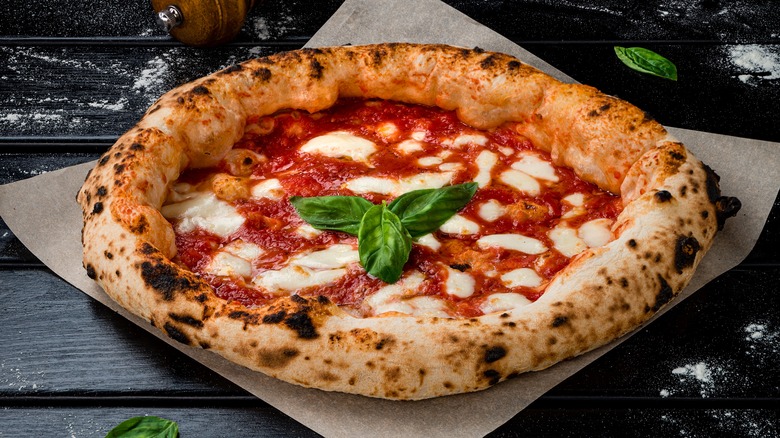Why Does Pizza Taste So Good In Italy?
From Chicago deep dish to New York slices as big as your head, pizza (and all its regional variations) may be one of the most beloved foods in the world today. Pizza has existed in some form since as early as A.D. 997, but the version we know and love today originated in the 1700s in the Campania region of Italy. It got its starts as a cheap and filling food for the working poor, but a popular (albeit unconfirmed) story rumors that pizza first experienced its moment in the spotlight when Queen Margherita of Savoy put her stamp of approval on a pie topped with tomatoes, basil, and mozzarella. Distinct from a plain cheese pie, her namesake pizza is still a staple on menus throughout the world today. While a royal blessing certainly would help elevate pizza's popularity, the food exploded into worldwide fame after Italian immigrants traveled to America and opened pizzerias in New York City.
Of course, there's nothing like pizza straight from the source. If you've ever eaten a pizza in Italy, you'll know that it is leagues above the stuff that gets delivered to your door in a cardboard box (though that's delicious in its own right). But what is it exactly that makes authentic Italian pizza taste so good? The answer is a combination of high-quality, locally sourced ingredients and cooking methods steeped in tradition.
A pizza is only as good as its ingredients
A good pizza starts with a good dough. Italian pizzas are made from finely-ground 00 flour, which has a high protein content and is low in gluten. This results in a dough that's stretchy yet sturdy enough to hold its shape under the weight of toppings. Italian pizza chefs, or pizzaiolos, have honed their craft and use traditional recipes and methods. For example, authentic Neapolitan dough is made with only double zero flour, water, salt, and yeast. It rises slowly (we're talking eight to 12 hours), which contributes to its light and airy texture. When baked at high heat in a wood-fired oven, the crust becomes ultra crispy and forms those delightful charred blisters, while still remaining soft on the inside.
Pizzas in the U.S. are often piled with toppings and dripping in grease, but the beauty of an Italian pizza, especially traditional Neapolitan pies, is letting a few simple but tasty ingredients sing. These ingredients, from peppery arugula to salty prosciutto, are produced in Italy and handled with care before being served fresh. Tomatoes used in red sauces are typically the highly coveted (and sometimes mislabeled) San Marzano tomatoes, which are exclusively grown in the volcanic soil around Naples and Mount Vesuvius, and known for their natural sweetness and low acidity.
Additionally, while pizza in America can be covered in cheese from crust to crust, pies in Italy use smaller amounts of fresh mozzarella to give the other ingredients a chance to shine. Mozzarella in Italy is made either from cow's milk or water buffalo's milk, resulting in a cheese that melts beautifully over pizza for a subtle creaminess. Since pizza-making is an art form in Italy, enjoying a slice in the Neapolitan Riviera might be one of life's greatest pleasures.

